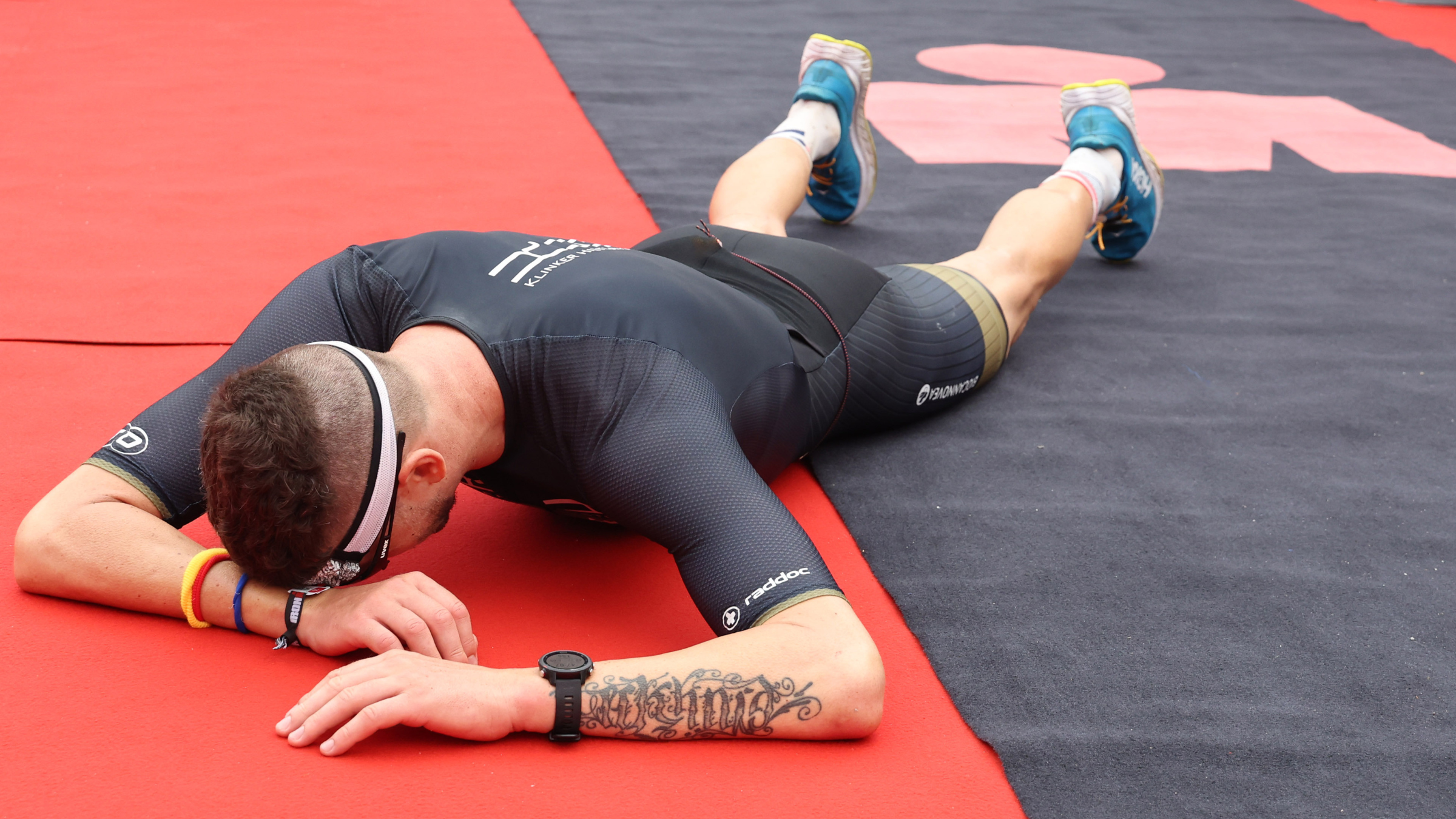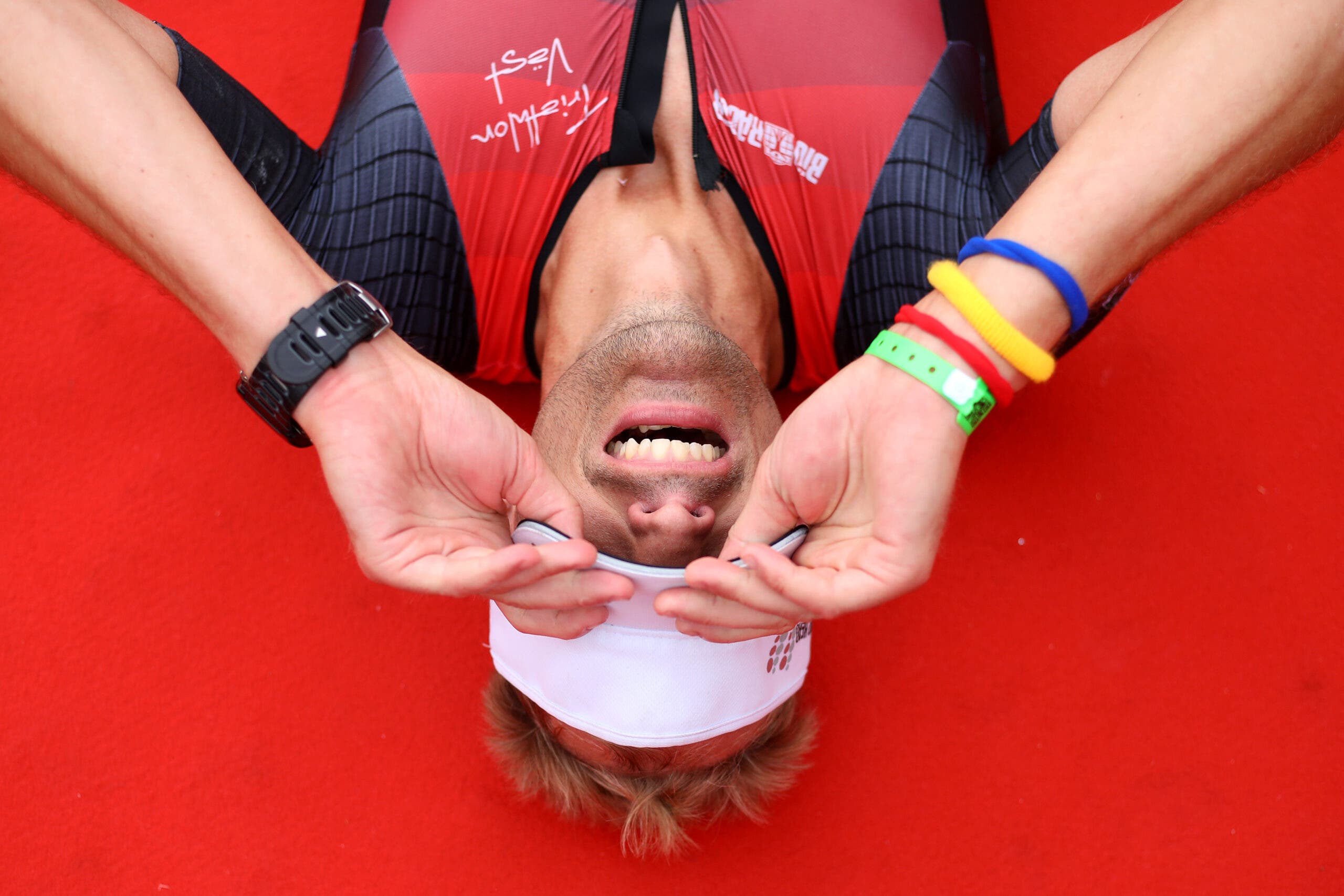Hurting More Does Not Make You a Badass

(Photo: Nigel Roddis/Getty Images)
Matteo De Luca, a 42-year-old triathlete and occasional ultrarunner, does not like to run with his wife. It’s not because she’s faster–or slower. It’s not because she gets up too early or likes to run too late. It’s because she likes to run on a soft dirt path that encircles the city where they live and he prefers to run on the road. “When I run on dirt I feel ‘off’ for the rest of the day. I know that I trained, but I don’t feel it in my body the way I do when I run on the street. Maybe I’m crazy, but it feels like I didn’t do enough.”
Though it might be tempting to dive into a scientific discussion comparing the physiological benefits of road versus trail running, the better question is–why does Matteo need to feel that he did “enough”?
Destination: Pain Cave
In case we need a refresher on pain vs. gain, plenty of research on human physiology debunks the idea that we only become fitter through painful workouts. Pain is subjective, varies from person to person, and is not dose-dependent. Research on muscle tissue damage and remodeling shows that athletes can have equal strength gains whether or not they experienced pain during or after training sessions. Studies on muscle soreness and adaptation have been clear that we can not conclude that pain is an indicator of successful training. There is even evidence to suggest that when athletes are in pain, they risk injury from alterations in their movements both during and after the workout.
But, no matter what the science says, even I can admit to tending to believe that when a workout hurts, I have achieved some new level of fitness. Like Matteo, I know that this is all in my head, so why do we still love to get in the Pain Cave?
This concept may be hardwired into our brains, according to Effort and Achievement by Toronto Metropolitan University Professor Hasko Von Kriegstein. His work states that our perception is that the more effort applied, the more heightened the sense of achievement. Research on effort explains that we gain a perception of just how hard we’re working based on a combination of somatic sensations like heavy breathing and muscle aches, psychosocial factors like personality and mood, and even temperature and duration of the session. If more pressure is exerted by any of those factors, we believe the training session to be more difficult and therefore believe we have applied more effort.
A recent study of amateur triathletes confirms the connection between hard efforts and achievement, showing that those who believed it took more grit to persevere in the sport had a higher sense of life satisfaction. Even in non-sport environments, research on prosocial activities like volunteering shows that people gain a greater sense of pride and meaning in actions that are perceived as laborious or requiring sacrifice.
RELATED: Triathletes Are Experts at the Pain Game
When it’s bad to hurt so good
If it were true that only the hard stuff is worth doing, we would all gain an infinitely increasing sense of accomplishment and wellbeing with infinitely painful physical exertion. The reality is that by focusing on pain and difficulty as benchmarks of success, we may be setting ourselves up for disaster. Landon Hildebrand, athlete, psychologist, and founder of Approach Psychology says that in the short term, we may tend to ignore the joys of competition, movement, and participation in favor of seeking the sensation of pain to confirm our success. In the long term, we teach ourselves to push through our distress signals, increasing the risk for both injury and overtraining.
When we miss the mark on our athletic goals, we are apt to draw negative conclusions not only about our performance but who we are as people. We might blame ourselves, often pushing even harder in subsequent training that may leave us burned out. Imposter syndrome inevitably crops up, making us feel that we aren’t “real triathletes” if we aren’t as trashed as we assume everyone else is after a race. Worse, Hildenbrand says that he has worked with athletes who take frustrations out on other people, blaming coaches, partners, and race directors for their failures. In our quest for pain, everyone hurts.
RELATED: Every Triathlete Needs To Understand Good Pain vs. Bad Pain
Everybody wants to be a badass
The problem may be that we are setting goals based on that very narrow view of success. Instead of thinking about goals that would bring us joy or sound like fun, we think about what would be prestigious, impressive, and unique. Many athletes may hope that their athletic achievements say something about who they are, which typically means that they are compensating for some insecurity. People like Matteo may need to feel that they did “enough” each day to manage those uncomfortable feelings.
This is why we might downplay the easy effort of a sprint triathlon, though they might be more enjoyable at times, and place more value on the arduous efforts like half or full Ironman distance races. Hildebrand explains that the messages that confirm this thought process are all around us. “It’s taught through everything we consume. Ancient fables, classic literature, stories of redemption, biographies, and so on. It is the hero story we all crave to confirm, something to prove we are special.” It makes sense to want to feel like a hero–life is unbelievably stressful and many of us need a bit of a boost right now. But, if we think that gutting it out is the only way to greatness, the story will likely be a short one.

How to break the pain/achievement cycle
There are two antidotes to the cycle of painful achievement. The first is to get rid of the goals altogether and just get out there and have fun. Taking a break from the need to achieve can allow us to explore different activities, or experience our favorite activities in different ways. When Triathlete editor Susan Lacke felt burned out and unmotivated, she turned to a series of wacky running challenges, chronicled in the book Running Outside the Comfort Zone, as a way to release some self-inflicted pressure and fall back in love with the sport. Psychologists like Katherine Price agree that this was an excellent plan. In her book, The Power of Fun: How to Feel Alive Again, she explains that the sense of fulfillment that we seek can be found through playfulness, connection, and flow–not pain, pressure, and exhaustion.
In real life, this might look like stepping away from a training plan for a while and just doing the workouts, rides, and runs that you enjoy. Take the prettiest route, the easiest, or the one that passes by the cafe with the awesome croissants. Sign up for the costume race, the one at a theme park, or even the one with the best post-race barbecue. It may also mean that you take some time off hard training to pursue something that you never have time for like a ceramics class, a family vacation, or learning how to rock climb. Time away isn’t forever–it’s for now.
The second option might work for those of us who still want to work toward a target. Get it Done: Surprising Lessons from the Science of Motivation confirms that people can feel successful after achieving any goal–not just the difficult ones. It doesn’t matter what you set your sights on, the act of setting the goal is the part that motivates people to achieve it. This means that you will likely feel just as sunny after the “I Beg Your (Dolly) Parton” 10k as you do after some of your A races. Of course, not every goal must be sport-related for us to feel good about it. Sometimes it can feel great to attack an old to-do list full of laundry and home improvements or “achieve” watching the entire season of The Sandman on Netflix.
Landon Hildebrand reminds us that if we are intent on focusing on getting our “pain fix” and straying away from enjoyment, we should be asking ourselves why this feels good to us. Are we feeling down about something else in our lives and using the sport to compensate? Are we trying to conform to what we think “real triathletes” are doing? Are we afraid that workouts aren’t effective enough? All of these questions deserve an answer. If you can’t address them on your own, set a goal to find a qualified mental healthcare practitioner or triathlon coach who can help. That’s an achievement you can believe in.
Jill Colangelo is a writer and researcher of mental health and ultra endurance sport. She has a BA and ALM in psychology and is a former triathlete and ultramarathoner.